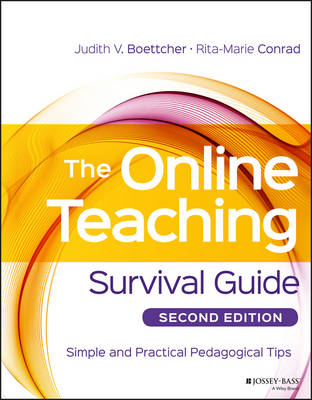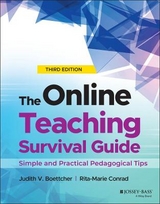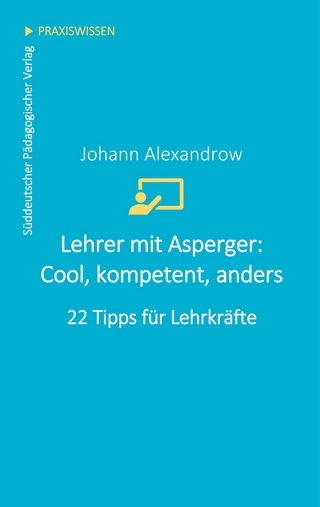
The Online Teaching Survival Guide
John Wiley & Sons Inc (Verlag)
978-1-119-14768-8 (ISBN)
- Titel erscheint in neuer Auflage
- Artikel merken
Essential reading for online instructors, updated to cover new and emerging issues and technologies The Online Teaching Survival Guide provides a robust overview of theory-based techniques for teaching online or technology-enhanced courses. Covering all aspects of online teaching, this book reviews the latest research in cognitive processing and related learning outcomes while retaining a focus on the practical. A simple framework of instructional strategies mapped across a four-phase timeline provides a concrete starting point for both new online teachers and experienced teachers designing or revamping an online course. Essential technologies are explored in their basic and expanded forms, and traditional pedagogy serves as the foundation for tips and practices customized for online learning. The tips cover course management, social presence, community building, integration of new technologies, discussion and questioning techniques, assessment, and debriefing, along with new coverage of intensive or accelerated courses, customizing learning strategies, developing expertise, advanced course design, and assessment techniques exclusive to this new second edition.
The theory and techniques of successful online teaching can be significantly different from those used face-to-face. With more and more classes being offered online, this book provides a valuable resource for taking your course to the next level. * Understand the technology used in online teaching * Learn specialized pedagogical tips and practices * Examine new research on cognition and learning * Adopt a clear framework of instructional strategies The explosion of online learning has created a demand for great online teachers. Increasingly, faculty who normally teach face-to-face are being asked to cover online courses yet comprehensive pedagogical resources are scarce. The learning curve is huge, and faculty need a practical approach to course design and management that can be quickly and easily implemented. The Online Teaching Survival Guide provides that essential resource, with a customizable framework and deeper exploration of effective online teaching.
Judith V. Boettcher is a nationally known consultant and author on online distance learning. She has led faculty support organizations at Penn State University, Florida State University, worked with faculty at the University of Florida and Duquesne University and is the founder and principal of Designing for Learning. She is a frequent keynoter at teaching and learning conferences, conducts faculty workshops on best practices in online learning, consults on program designs, and coaches individual faculty. Judith is the coauthor with Rita-Marie Conrad of two editions of the Faculty Guide for Moving Teaching and Learning to the Web (1999, 2004) published by the League for Innovation and the first edition of The Online Teaching Survival Guide: Simple and Practical Pedagogical Tips (Jossey-Bass, 2010). Rita-Marie Conrad is an online educator, award-winning author, and digital learning strategist in the Center for Teaching and Learning at the University of California, Berkeley. She works with hundreds of faculty nationally as an online workshop facilitator on the topic of designing online instruction for the Learning Resources Network (LERN). Rita-Marie developed and taught online courses at Florida State University as well as several other universities. She also served as the instructional strategist for Duke University's Institute for Educational Excellence. Rita-Marie co-authored The Faculty Guide for Moving Teaching and Learning to the Web (1999, 2004), Engaging the Online Learner (2004, 2011) which received the 2012 IAP Distance Education Book award, Assessing Learners Online (2008), The Online Teaching Survival Guide: Simple and Practical Pedagogical Tips (2010), and Continuing to Engage the Online Learner (2012).
List of Tables, Figures, and Exhibits xv Foreword xvii Preface xxi Acknowledgments xxii About the Authors xxiii Introduction xxv PART ONE: CORE PRINCIPLES AND BEST PRACTICES OF ONLINE TEACHING AND LEARNING 1 1 Teaching Online: The Big Picture 3 Preparing to Teach in the Online and Blended Environments 4 Uh ]Oh. What Did I Say I Would Do? 4 Is This You? 5 The Definition of a Course 6 How Do Online and Blended Courses Differ from Traditional Courses? 8 Types of Online and Blended Courses 10 The Four Stages of a Course 13 Learning Theories and Theorists 13 Summary and What s Next 22 2 Pedagogical Principles for Effective Teaching and Learning: Ten Core Learning Principles 23 Background of the Ten Core Learning Principles 25 Ten Core Learning Principles 26 Principle 1: Every Structured Learning Experience Has Four Elements, with the Learner at the Center 27 Principle 2: Learners Bring Their Own Personalized and Customized Knowledge, Skills, and Attitudes to the Learning Experience 30 Principle 3: Faculty Mentors Are the Directors of the Learning Experience 32 Principle 4: All Learners Do Not Need to Learn All Course Content; All Learners Do Need to Learn the Core Concepts 33 Principle 5: Every Learning Experience Includes the Environment or Context in Which the Learner Interacts 35 Principle 6: Every Learner Has a Zone of Proximal Development That Defines the Space That a Learner Is Ready to Develop into Useful Knowledge 36 Principle 7: Concepts Are Not Words But Organized and Interconnected Knowledge Clusters 37 Principle 8: Different Instruction Is Required for Different Learning Outcomes 38 Principle 9: Everything Else Being Equal, More Time on Task Equals More Learning 39 Principle 10: We Shape Our Tools, and Our Tools Shape Us 40 Summary and What s Next 41 3 Best Practices for Teaching Online: Ten Plus Four 43 Best Practices for Online and Blended Teaching and Learning 44 Best Practice 1: Be Present at Your Course 44 Three Types of Presence 46 Best Practice 2: Create a Supportive Online Course Community 47 Best Practice 3: Develop a Set of Explicit Workload and Communication Expectations for Your Learners and for Yourself 48 Best Practice 4: Use a Variety of Large Group, Small Group, and Individual Work Experiences 50 Best Practice 5: Use Synchronous and Asynchronous Activities 51 Best Practice 6: Ask for Informal Feedback Early in the Term 52 Best Practice 7: Prepare Discussion Posts That Invite Responses, Questions, Discussions, and Reflections 53 Best Practice 8: Think Digital for All Course Content 54 Best Practice 9: Combine Core Concept Learning with Customized and Personalized Learning 55 Best Practice 10: Plan a Good Closing and Wrap Activity for the Course 57 Four More Best Practices for Online and Blended Teaching and Learning 57 Best Practice 11: Assess as You Go by Gathering Evidences of Learning 58 Best Practice 12: Rigorously Connect Content to Core Concepts and Learning Outcomes 58 Best Practice 13: Develop and Use a Content Frame for the Course 59 Best Practice 14: Design Experiences to Help Learners Make Progress on Their Novice ]to ]Expert Journey 60 Summary and What s Next 61 4 Technology Tools to Support Teaching and Learning 62 Guidelines for Choosing and Using Technology Tools 63 Basic Set of Technology Tools for Online and Blended Teaching and Learning 65 Basic Set of Digital Technology Tools: Their Teaching and Learning Purposes 66 More Thoughts on the Basic Tools 70 Tools for Practicing Contextual Knowledge and Exploring Possibilities 74 Staying in Sync with Tools 77 5 Four Phases of a Course: Themes and Happenings 79 Phase 1 Course Beginnings: Starting Off on the Right Foot 79 Phase 2 Early Middle: Keeping the Ball Rolling 85 Phase 3 Late Middle: Letting Go of the Power 90 Phase 4 Closing Weeks: Pruning, Reflecting, and Wrapping Up 97 Summary and What s Next 103 PART TWO: SIMPLE, PRACTICAL, AND PEDAGOGICALLY BASED TIPS 105 6 Phase 1: Course Beginnings: Starting off on the Right Foot 107 Tips for the Course Beginnings 107 Course Beginnings Tips Overview 109 Getting Started Preparing Your Syllabus and Course Site 109 Getting Started Preparing Your Syllabus and Course Site 110 CB Tip 1: Essential Elements of an Online or Blended Course Syllabus and Course Site 110 CB Tip 2: More on the Significant Elements of an Online or Blended Syllabus 118 CB Tip 3: Creating a Syllabus That Jump ]starts Learning 122 CB Tip 4: Using Bookending to Add Structure and Meaning to Your Course 127 CB Tip 5: Generating Energy and Purpose with Specific Learning Goals 130 Getting Started Launching Your Course 134 CB Tip 6: Hitting the Ground Running: Maximizing the First Week 134 CB Tip 7: Launching Your Social and Cognitive Presence 136 CB Tip 8: Getting to Know Students Minds: The Vygotsky Zone of Proximal Development 140 CB Tip 9: Getting into the Swing of a Course: Is There an Ideal Weekly Rhythm? 142 Creating and Managing Discussion Posts 145 CB Tip 10: The Why and How of Discussion Boards: Their Role in the Online Course 145 CB Tip 11: Characteristics of Good Discussion Questions 148 CB Tip 12: Power Questioning for Meaningful Discussions 154 CB Tip 13: Response Posts A Three ]Part Structure 158 CB Tip 14: Discussion Wraps: A Useful Cognitive Pattern or a Collection of Discrete Thoughts? 160 CB Tip 15: Using Discussion Forums to Gather Evidence of Learning 162 CB Tip 16: Feedback in Discussion Posts How Soon, How Much, and Wrapping Up 166 CB Tip 17: The Faculty Role in Blended and Online Courses 168 Summary and What s Next 171 7 Phase 2: Keeping the Ball Rolling in the Early Middle 172 Tips for the Early Middle 172 EM Tip 1: Tools for Teaching Presence: E ]mails, Announcements, and Discussion Forums 174 EM Tip 2: Monitoring Student Progress Using Learning Management Systems 177 EM Tip 3: Early Feedback Loop from Learners to You 178 EM Tip 4: Early Feedback Tools: Rubrics, Quizzes, and Peer Review 181 EM Tip 5: Steps in Memory ]Making: What Teaching Behaviors Make a Difference 184 Summary 187 EM Tip 6: Tips for Making Your Grading Time Efficient and Formative for Learners 188 EM Tip 7: Dealing with Difficult Students What Do You Do? 191 Building the Cognitive Presence 195 EM Tip 8: Building Cognitive Presence Using the Practical Inquiry Model 196 EM Tip 9: Core Concepts of a Course Do You Know Yours? 198 EM Tip 10: Designing Assessment Plans for Online and Blended Courses 202 EM Tip 11: Three Best Assessment Practices 205 EM Tip 12: Assignments for the Evaluating and Creating Levels of Bloom s Taxonomy 210 Strategies and Tools for Building Community 213 EM Tip 13: Collaborating with Groups of Two or Three Casual Grouping 214 EM Tip 14: Group Projects in Online Courses: Setting Up and Structuring Groups 216 EM Tip 15: Using Synchronous Collaboration Tools 220 EM Tip 16: Using Audio and Video Resources to Create a More Engaging Course 222 Summary and What s Next 225 8 Phase 3: Letting Go of Power in the Late Middle 226 Overview of Late Middle Tips 226 Going Deeper: Leveraging the Power of Questions 228 LM Tip 1: Questions and Answers: Upside Down and Inside Out 228 LM Tip 2: Three Techniques for Making Your Students Knowledge Visible 230 LM Tip 3: Developing Rigor in Our Questioning: Eight Intellectual Standards 232 LM Tip 4: Moving Beyond Knowledge Integration to Defining Problems and Finding Solutions 237 Feedback for Cognitive Growth 239 LM Tip 5: Are You Reading My Postings? Do You Know Who I Am? Simple Rules for Feedback in Online Learning 239 LM Tip 6: Feedback on Assignments: Being Timely and Efficient 244 LM TIP 7: Substantive Feedback: Doing It Wisely and Well 248 LM Tip 8: Rubrics for Analyzing Critical Thinking 252 Assessing Learning as You Go with Projects 255 LM Tip 9: Customizing and Personalizing Learning Projects 256 LM Tip 10: Managing and Facilitating Group Projects 259 LM Tip 11: Assessing Group Projects 261 LM Tip 12: Four Effective Practices During Project Time 264 Community Empowerment and Social Networking 267 LM Tip 13: Course Middles and Muddles: Souped ]Up Conversations That Help Build Community 268 LM Tip 14: Using Social Networking Techniques to Build a Learning Community 269 LM Tip 15: Experts: A Touch of Spice 272 Summary and What s Next 275 9 Phase 4: Pruning, Reflecting, and Wrapping Up 277 Tips for the Closing Weeks 277 Meaningful Projects and Presentations 279 CW Tip 1: Using What ]If Scenarios: Flexing Our Minds with Possibilities 279 CW Tip 2: Stage 3 of a Learning Community: Stimulating and Comfortable Camaraderie 281 CW Tip 3: Learners as Leaders 283 CW Tip 4: Course Wrapping with Concept Mapping: Capturing Course Content Meaningfully 285 CW Tip 5: Using Case Studies in Online Courses: Making Content Real 290 Preparing for the Course Wrap 294 CW Tip 6: Pausing, Reflecting, and Pruning Strategies 294 CW Tip 7: Closing Experiences: Wrapping Up a Course with Style 296 CW Tip 8: Real ]Time Closing Gatherings: Stories and Suggestions 299 CW Tip 9: Debriefing Techniques: What One Change Would Students Recommend? 302 Conclusion and What s Next 303 10 Teaching Accelerated Intensive Courses 305 Tips for Intensive Courses (IC) 305 IC Tip 1: Designing for Intensive Courses Using Content Framing and Case Studies 306 IC Tip 2: High ]Impact Practices for Short Courses: Reflections, Patterns, and Relationships 308 IC Tip 3: Developing Expertise in Short Courses: Can It Be Done? 313 Conclusion and What s Next 315 PART THREE: CONTINUING YOUR JOURNEY TO EXPERTISE 317 11 What s Next: Reflecting and Looking Forward 319 Reflecting and Looking Forward Using the Four Course Phases 319 Reflecting and Looking Forward with the Learning Experiences Framework 325 Advice from Fellow Online Instructors 328 Conclusion: Innovation as a Three ]Phase Process 330 Appendix: Resources for Learning More about the Research and Theory of Teaching Online 333 References 339 Index 359 Subject Index 363
| Erscheinungsdatum | 13.10.2016 |
|---|---|
| Verlagsort | New York |
| Sprache | englisch |
| Maße | 209 x 284 mm |
| Gewicht | 988 g |
| Themenwelt | Sozialwissenschaften ► Pädagogik ► Bildungstheorie |
| ISBN-10 | 1-119-14768-9 / 1119147689 |
| ISBN-13 | 978-1-119-14768-8 / 9781119147688 |
| Zustand | Neuware |
| Haben Sie eine Frage zum Produkt? |
aus dem Bereich



